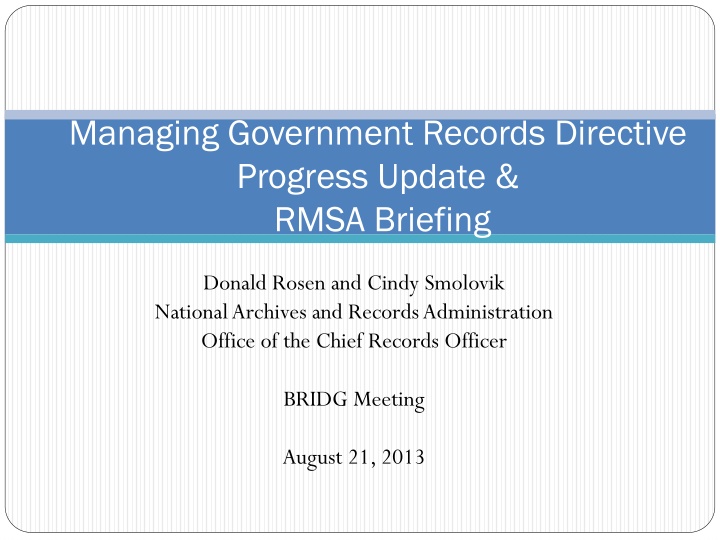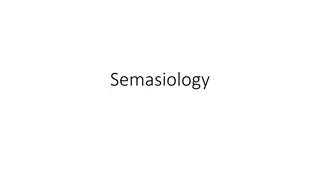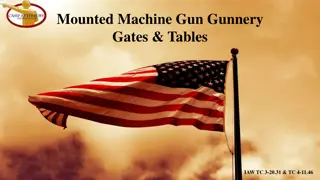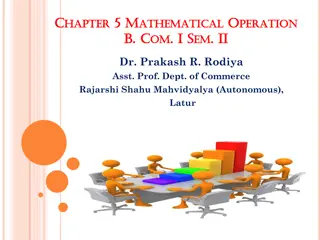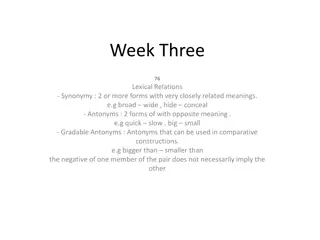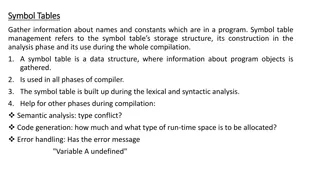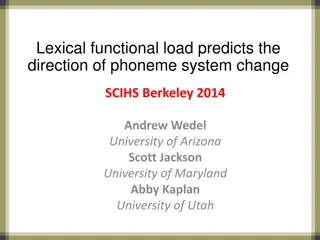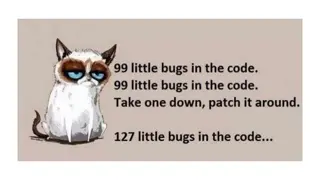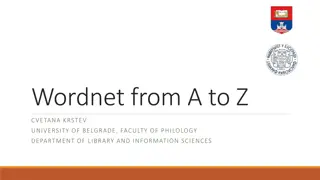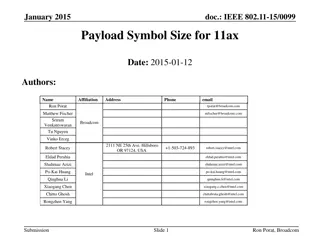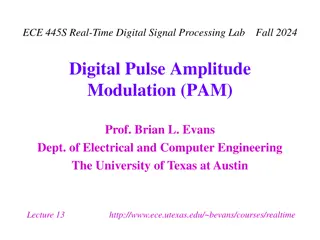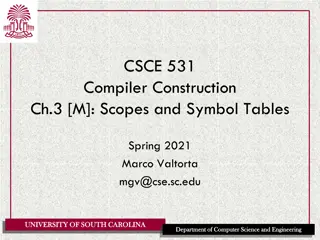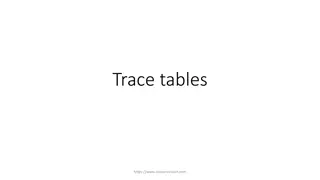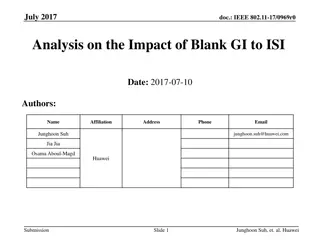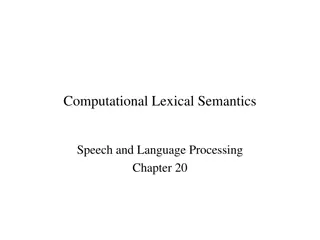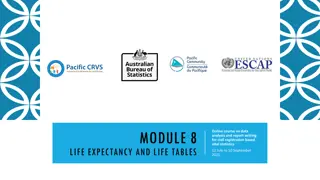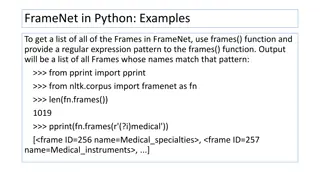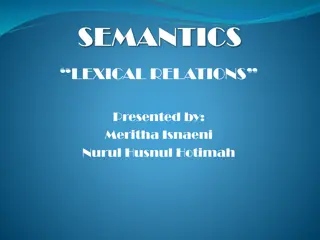Overview of Symbol Tables and Lexical Analysis
Symbol tables are essential data structures used by compilers to store information about identifiers in source code. The tables contain details such as identifiers' lexemes, types, memory positions, and more. Lexical analysis involves tokenizing source code based on predefined patterns, like keywords and lexemes. Additionally, the content discusses definitions related to alphabets, strings, languages, prefixes, and suffixes, providing a comprehensive understanding of fundamental concepts in computer science.
Download Presentation

Please find below an Image/Link to download the presentation.
The content on the website is provided AS IS for your information and personal use only. It may not be sold, licensed, or shared on other websites without obtaining consent from the author.If you encounter any issues during the download, it is possible that the publisher has removed the file from their server.
You are allowed to download the files provided on this website for personal or commercial use, subject to the condition that they are used lawfully. All files are the property of their respective owners.
The content on the website is provided AS IS for your information and personal use only. It may not be sold, licensed, or shared on other websites without obtaining consent from the author.
E N D
Presentation Transcript
Managing Government Records Directive Progress Update & RMSA Briefing Donald Rosen and Cindy Smolovik National Archives and Records Administration Office of the Chief Records Officer BRIDG Meeting August 21, 2013
Managing Managing Government Government Records Directive Records Directive By December 31, 2013 NARA issues email guidance NARA revises transfer guidance NARA produces plan for automated management of electronic records NARA issues cloud reporting requirements NARA evaluates feasibility of data at rest NARA establishes a Community of Interest NARA identifies RM analytical tool NARA/OPM establish RM occupational series Agency Records Officers identify all unscheduled records, regardless of format SAOs ensure permanent records identified for transfer and reported to NARA Office of the Chief Records Officer National Archives and Records Administration 2
New Email Guidance New Email Guidance By December 31, 2013, NARA will issue new guidance that describes methods for managing, disposing, and transferring email. Completed Govt. and Public Review NARA is finalizing Bulletin and Training Plan Office of the Chief Records Officer National Archives and Records Administration 3
Revise Transfer Guidance Revise Transfer Guidance By December 31, 2013, NARA will complete, and make available, revised guidance, including metadata requirements, for transferring permanent electronic records, to include additional sustainable formats commonly used to meet agency business needs. Completed NARA-wide review Preparing for Government and OMB Review Office of the Chief Records Officer National Archives and Records Administration 4
Investigate and stimulate applied Investigate and stimulate applied research in automated technologies research in automated technologies NARA, the Federal Chief Information Officers Council and the Federal Records Council will work with private industry and other stakeholders to produce economically viable automated records management solutions. Created ERM Automation Working Group on OMB Max Industry Day: September 10 half-day conference for vendor audience https://max.omb.gov/community/x/5QlfJw Office of the Chief Records Officer National Archives and Records Administration 5
Establish RM Occupational Series Establish RM Occupational Series By December 31, 2013, OPM will establish a formal records management occupational series to elevate records management roles, responsibilities, and skill sets for agency records officers and other records professionals OPM has completed Focus Groups (July August) Product (possibly) a RM Flysheet Office of the Chief Records Officer National Archives and Records Administration 6
Reporting Requirements Reporting Requirements SAO Template distributed August 20, 2013 SAO Report (October 1 - December 31,2013) RMSA (October 1 - December 31,2013) Office of the Chief Records Officer National Archives and Records Administration 7
Records Management Self Assessment 2012 Report Summary and What s new for 2013 Cindy Smolovik Office of the Chief Records Officer National Archives and Records Administration 8
RMSA Report 2012 RMSA Report 2012 Available at: http://www.archives.gov/records-mgmt/resources/self-assessment.html Agency score reports were sent last October (contact me if you did not get one, or need another) General questions: rmselfassessment@nara.gov Cindy Smolovik cindy.smolovik@nara.gov Office of the Chief Records Officer National Archives and Records Administration 9
Percentage in each Risk Factor* RMSA 2012: Statistics RMSA 2012: Statistics High Risk 36% Respondents 281 agencies were invited to participate 241 responded Low Risk 20% This is an 85% response rate Moderate Risk 44% *Risk Factors High-scores under 60 Moderate-scores 60-89 Low-scores 90-100 Office of the Chief Records Officer National Archives and Records Administration 10
Some Improvement shown in 2012 Some Improvement shown in 2012 Agencies moved to low and moderate risk categories More agency RM staff participate in design and develop of electronic systems or in issues with electronic records Increase in permanent records transfers using Electronic Records Archives (ERA) Office of the Chief Records Officer National Archives and Records Administration 11
Recommendations Recommendations Agencies must: Senior Agency Officials must: Take responsibility for effective records and information management Ensure compliance with records management regulations and policies Ensure support for broader RM Directive goals as well as Agency Records Officers Create performance goals Establish performance measures Create or improve internal controls for reasonable assurance of compliance Continue the pursuit of technological solutions Office of the Chief Records Officer National Archives and Records Administration 12
Data Collection for 2013 Data Collection for 2013 RMSA aligns with Directive Reporting Deadlines Advanced Questionnaire in September 2013 Open for response October 1, 2013 thru December 31, 2013 Directive data due December 31, 2013 2.2: ID of Permanent Records reports 2.5: ID of Unscheduled Records Office of the Chief Records Officer National Archives and Records Administration 13
Whats else is new for 2013? What s else is new for 2013? Expanded response time from one month to three months Brought back a few questions on email and storage (non-scored) Added a Non-Applicable response to some questions with a required explanation Office of the Chief Records Officer National Archives and Records Administration 14
Next steps Next steps Please provide any changes in who should get the RMSA link or other email address changes to rmselfassessment@nara.gov Advance version of the questionnaire in MS Word will be sent mid-September Invitation with link to the tool will be sent October 1 - Please do NOT forward this link, if you want someone else to participate please email us! Office of the Chief Records Officer National Archives and Records Administration 15
Contact Information Contact Information All Updates on our progress can be found on the Records Express blog at http://blogs.archives.gov/records-express/ General questions: PRMD@nara.gov Don Rosen donald.rosen@nara.gov Cindy Smolovik cindy.smolovik@nara.gov Office of the Chief Records Officer National Archives and Records Administration 16
